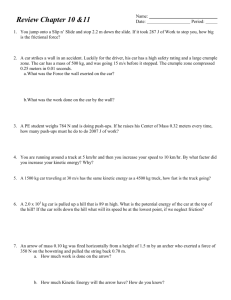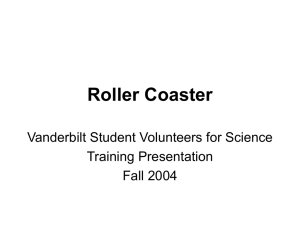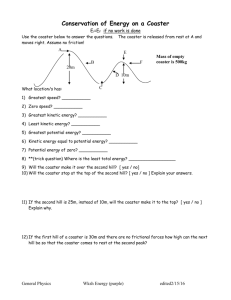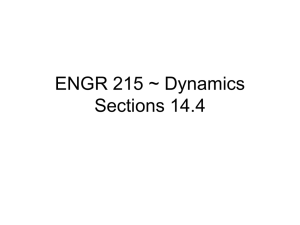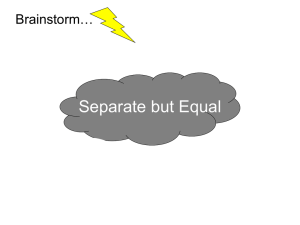Questions - Review so Far
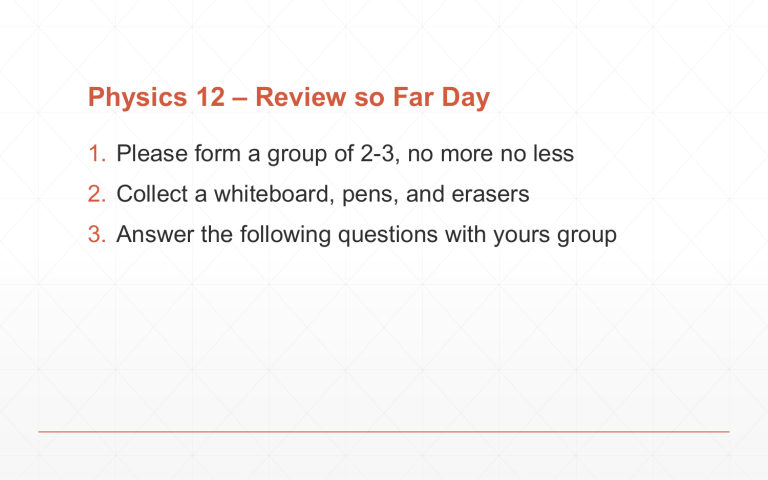
Physics 12 – Review so Far Day
1.
Please form a group of 2-3, no more no less
2.
Collect a whiteboard, pens, and erasers
3.
Answer the following questions with yours group
Q1: Work
A force is applied to a crate at an angle of 25 o above the horizontal.
The crate is dragged across the deck a distance of 2.5 m. If the amount of work done after it has been moved is 1 210 J, what was the applied force?
Q1: Work
A force is applied to a crate at an angle of 25 o above the horizontal.
The crate is dragged across the deck a distance of 2.5 m. If the amount of work done after it has been moved is 1 210 J, what was the applied force?
This is a simple problem, all we have to do is solve it for F !
W
=
F
D d cos q
F
=
W d cos q
=
2.5
1 210 Nm m
( cos 25
) o
=
530 N
Q2. Work and Kinetic Energy
A net 6 500 N force is applied to a resting 1 500 kg car, moving it forward. What is its kinetic energy and speed after being displaced
150 m?
Q2. Work and Kinetic Energy
A net 6 500 N force is applied to a resting 1 500 kg car, moving it forward. What is its kinetic energy and speed after being displaced
150 m?
First we calculate the amount of work the force does, this will give us the amount of kinetic energy the car ends up with.
W
=
1
2 mv
2
W
=
F
D d
=
6500 N
(
150 m
)
=
975 000 J v
=
2 W v
=
æ
ææ kgm s
2 m
æ
ææ
= m 1 500 kg
36 m s
Q3. Conservation of Energy I
The first hill on a roller coaster is 94 m tall, the second hill is 68 m tall.
If it starts from rest on the first hill, what theoretical speed will the roller coaster have on the second hill?
Q3. Conservation of Energy I
The first hill on a roller coaster is 94 m tall, the second hill is 68 m tall.
If it starts from rest on the first hill, what theoretical speed will the roller coaster have on the second hill?
g y
0 mgy o
+
1
2 mv o
2
= g y
+
1
2 v
2
= mgy gy
0
g y
=
1
2 v
2
+
1 mv
2
2 v
=
2
(
0
y
) v
=
æ
ææ m s
2
æ
ææ
(
94 m
-
68 m
)
=
23 m s
Q4. Conservation of Energy II
A sled and rider together have a mass of 87 kg. They are atop a hill elevated at
42.5
o . They slide down the slope a distance of 35 m and reach the bottom. Find the speed at the bottom of hill.
Assume no friction.
y
d
Q4. Conservation of Energy II
A sled and rider together have a mass of 87 kg. They are atop a hill elevated at
42.5
o . They slide down the slope a distance of 35 m and reach the bottom. Find the speed at the bottom of hill.
Assume no friction.
v
=
18 m s y
d
Q5. Power Basics I
A human fly climbs up the outside of tall building to thrill the teeming hordes of earthlings below who fear he will fall to his doom. So if the 52 kg human fly takes 18 minutes to climb a 350 m building, how much power did he develop in the climb?
Q5. Power Basics I
A human fly climbs up the outside of tall building to thrill the teeming hordes of earthlings below who fear he will fall to his doom. So if the 52 kg human fly takes 18 minutes to climb a 350 m building, how much power did he develop in the climb?
P
=
W t
= mgy t
=
52 kg
æ
ææ
9.8
m s
2
æ
ææ
350 m
æ
ææ
1
18 min
æ æ
1 min
ææ ææ
60 s
æ
ææ
=
170 W
Q5. Power Basics II
A 47 kg bicycle rider develops 0.26 hp. She rides the Featherlite
250 which has a mass of 2.3 kg. Anyway, the rider must climb a
235 m hill. How much time will this take?
P
=
0.26
hp
æ
ææ
746 W
1 hp
æ
ææ
=
194 W
Q5. Power Basics II
A 47 kg bicycle rider develops 0.26 hp. She rides the Featherlite
250 which has a mass of 2.3 kg. Anyway, the rider must climb a
235 m hill. How much time will this take?
P
=
0.26
hp
æ
ææ
746 W
1 hp
æ
ææ
=
194 W t
=
(
47 kg
+
2.3
kg
) æ
ææ
9.8
m s
2
æ
ææ
(
235 m
)
J
194 s
=
585.2
J
J s
=
590 s
Q6. Power… a little more challenging
A 15.5 kg block is pulled across a flat deck at a constant speed of 3.0 m/s with a rope. The rope is horizontal to the deck. The coefficient of friction is 0.330. How much power does it take to do this?
Q6. Power… a little more challenging
A 15.5 kg block is pulled across a flat deck at a constant speed of 3.0 m/s with a rope. The rope is horizontal to the deck. The coefficient of friction is 0.330. How much power does it take to do this?
F f
=
T
= m mg
=
( kg
) æ
ææ
9.8
P
=
Fv
=
50.1
N
æ
ææ
3.0
m
æ s
ææ m
æ s
2
=
150 W
ææ
=
50.1
N f n mg
T
The Sojourner rover
